| Article ID | Journal | Published Year | Pages | File Type |
|---|---|---|---|---|
| 5977318 | International Journal of Cardiology | 2013 | 7 Pages |
BackgroundRecent evidence indicates that epicardial adipose tissue (EAT) expresses uncoupling protein-1 (UCP1), a marker of brown adipocytes. However, the putative effects of the presence of brown adipocytes in EAT remain unknown.MethodsThe mRNA expression of genes related to brown adipocyte-mediated thermogenesis was measured in the fat samples collected from the epicardial-, mediastinal- and subcutaneous-depots of patients undergoing coronary artery bypass grafting. Both univariate and multivariate analyses were then utilized to determine any association between gene expression and the anthropometrics and fasting blood chemistries of these patients.ResultsEAT exhibited significantly higher expression of UCP1 and cytochrome c oxidase subunit-IV (COX-IV) compared to mediastinal- and subcutaneous-fat depots (P â¤Â 0.05). EAT expression of UCP1 (r = 0.50), COX-IV (r = 0.37) and lipoprotein lipase (LPL) (r = 0.58) positively associated with circulating levels of HDL-cholesterol (P â¤Â 0.05). In addition, EAT expression of LPL, acyl coA dehydrogenase-short, -medium and -long chain genes associated negatively with circulating TG levels (P â¤Â 0.05).ConclusionsAbundance of UCP-1 in the EAT relative to other fat depots confirms the presence of brown adipocytes in human EAT. Furthermore, the correlations among the EAT expression of thermogenesis-related genes with the circulating HDL and TG levels indicate that presence of active brown adipocytes shares a functional association with the circulating plasma lipids in humans.
